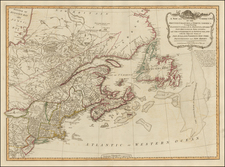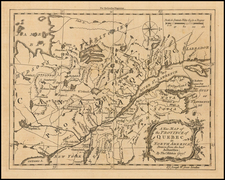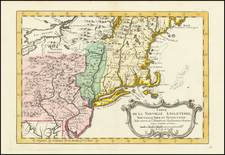The extremely important and exceedingly rare printed plan of the Habitation of St. Croix Island, the earliest European settlement in the region of New England and the Canadian Maritimes, part of a set of the series of the earliest printed charts of North America, by the great explorer Samuel de Champlain
In June 1604, a French mission under the Sieur de Mons, of which Samuel de Champlain was a principal, built a habitation on St. Croix Island, a small islet (today's Dochet Island), now on the border of Maine and New Brunswick. Importantly, this represented the first attempt by Europeans to found a permanent settlement in New England and the Canadian Maritimes.
The plan depicts the habitation in considerable detail, albeit in a somewhat idealized form. While the expedition made concerted efforts to develop the settlement on an organized plan, the view here appears more like that of an aristocratic estate in the French countryside, than a frontier outpost on the edge of a vast and mysterious land.
The view embraces the entire settlement, taking up the upper two-thirds of the island. A detailed numbered key below the image labels the habitation's various buildings and attributes. A) notes the residence of Sieur de Mons, B) is the Common Lodge where it is said the residents repaired during "times of rain", c) is the Munitions Magazine, D) is the Iron Foundry, H) is the Bakery, I) is the Kitchen, L) is the Pantry or Food Store, M) depicts Gardens, 0) shows the Palisades, or Fortifications, P) portrays Champlain's residence, while subsequent letters label the residences of other prominent colonists and artisans.
In spite of the elaborate plan and seemingly well-appointed facilities, the location of the settlement proved to be injudicious. The isolation of the location made it difficult to gather food and firewood, and during the long winter that followed, 36 of the 79 colonists perished. The settlement was abandoned in the spring of 1605.
Samuel de Champlain (1470-1535) was one of the greatest explorers and cartographers of his era, and the founding father of what would one day become Canada. Inspired by the voyages of his countryman, Jacques Cartier, he made his first voyage to Canada in 1603. Upon his return to France, his reports encouraged Henry IV to finance a colonizing expedition, and the colonizing company was given a royal monopoly on all settlement and fur trading rights between the 40th and 45th parallels. In 1604, Champlain joined the venture as second in command to Pierre Dugua, the Sieur de Mons, and it was on this voyage that they founded the habitation of Isle de Sainte Croix. The settlers later moved to the more hospitable site of Port Royal (Annapolis Royal, Nova Scotia), while Champlain explored the Massachusetts coast in search of alternate sites. These plans were abandoned due to the hostility of the indigenous Monomoyick tribe.
Within a couple of years, Champlain assumed supreme leadership over the French colonization venture. In 1608, he founded Quebec City on an impressive promontory overlooking the St. Lawrence River. Having overcome much initial adversity, this settlement proved to be successful, becoming the capital of a vast French domain that eventually extended down to the Gulf of Mexico and over to the Rockies.
Champlain, passionately dedicated to the mission of securing the permanence of New France, had to return to France frequently to raise funds and encourage new settlers to join the enterprise. A cornerstone of his campaign was the publication of his greatest work, Les Voyages dv Sievr de Champlain (Paris, 1613), a detailed narrative of the founding of New France, which included the present plan. Champlain later became the governor of New France, and by the time he died on Christmas Day 1635, he knew that he had succeeded in his mission.
The St. Croix settlement, or rather the confirmation of its true location, became the focus of a politically charged archaeological search at the end of the 18th-century. Curiously, in spite of Champlain's detailed account and fine maps, over the two succeeding centuries the exact location of the habitation was contested. Finding the true location of the habitation proved critical, for the Treaty of Paris (1783), which ended the American Revolution and set the boundaries between British North America (Canada) and the newly independent United States was set to run along the middle of the St. Croix River.
The Americans claimed that the actual St. Croix River was not the river currently known to be the St. Croix (and indeed claimed as such by the British), but was instead the 'Scoodic River'. They asserted that the true St. Croix was actually another river that entered Passamaquoddy Bay further to the east, today known as the Magaguadavic River. If the American claim prevailed, and the border was moved eastward, Britain would loose possession of the important Loyalist town of St. Andrew's.
For the British, saving St. Andrew's depended on proving that the 'Scoodic River' was in fact the true St. Croix named by Champlain. After an exhaustive search, in 1795, George Sproule, the Surveyor General of New Brunswick, located the buried ruins of the St. Croix Habitation on Dochet Island, thereby proving the British claim. The international boundary runs up the middle of this river to this day, with Dochet Island being located on the Maine side of the line.
The present plan of the Habitation of St. Croix is a critical artifact illustrating the early history of both New England and the Canadian Maritimes. The complete book in which the plan was published retails for approximately $750,000. As a separately-available map, the present plan is of the utmost rarity, this being the first example on the market in many years.









![[ Pictish Man Holding Severed Head ] Picti icon](https://storage.googleapis.com/raremaps/img/small/99837.jpg)

![Carte Reduite Des Costes Orientales De L'Amerique Septentrionale . . . contenant L'Isle Royale . . . La Nouvelle Angleterre et la Nouvelle Yorc . . . MDCCLVII [with Plan of Boston Harbor] Plan du Havre de Baston](https://storage.googleapis.com/raremaps/img/small/80006.jpg)


